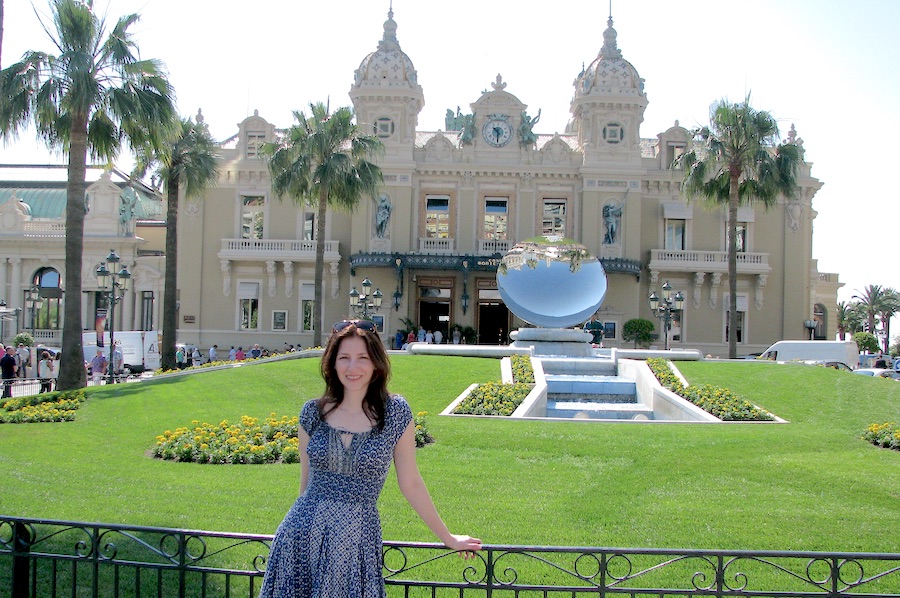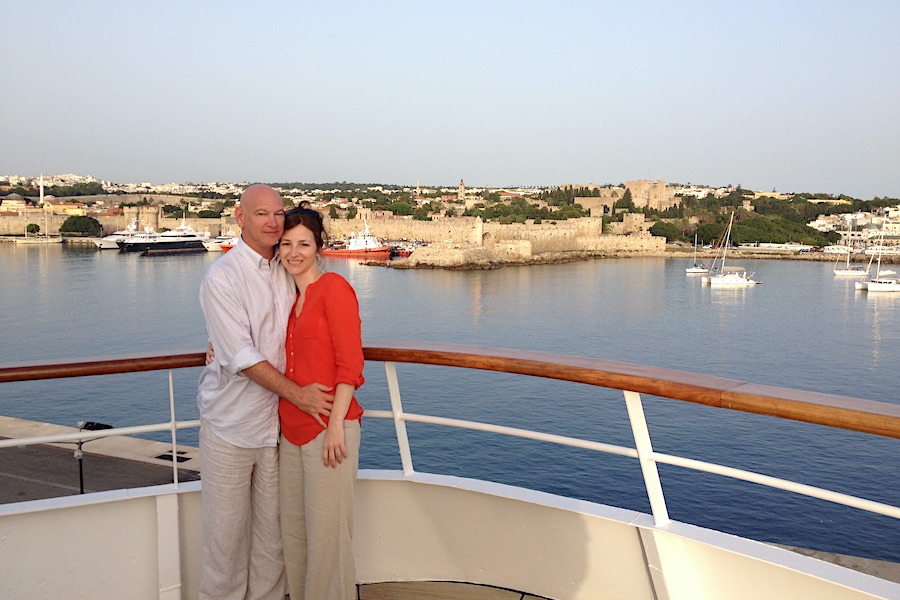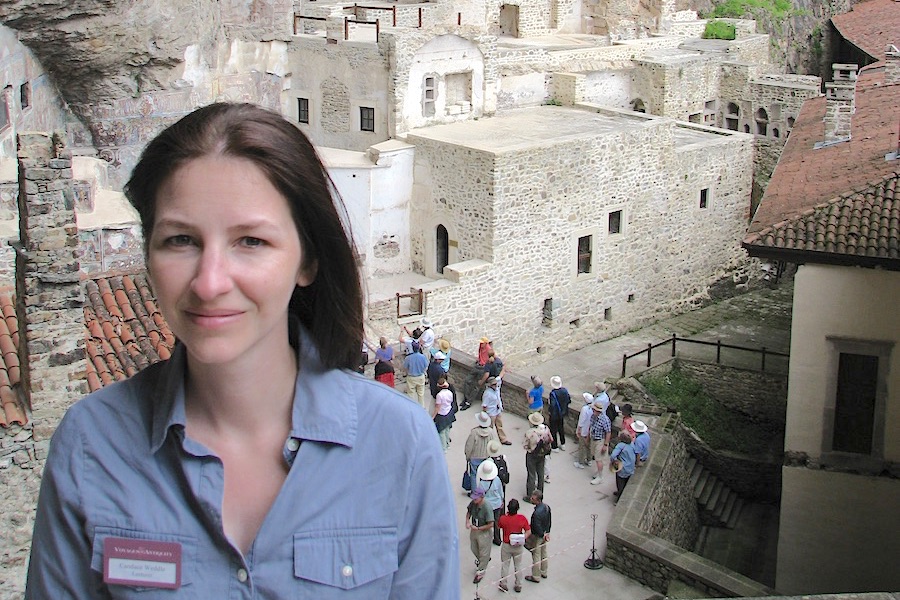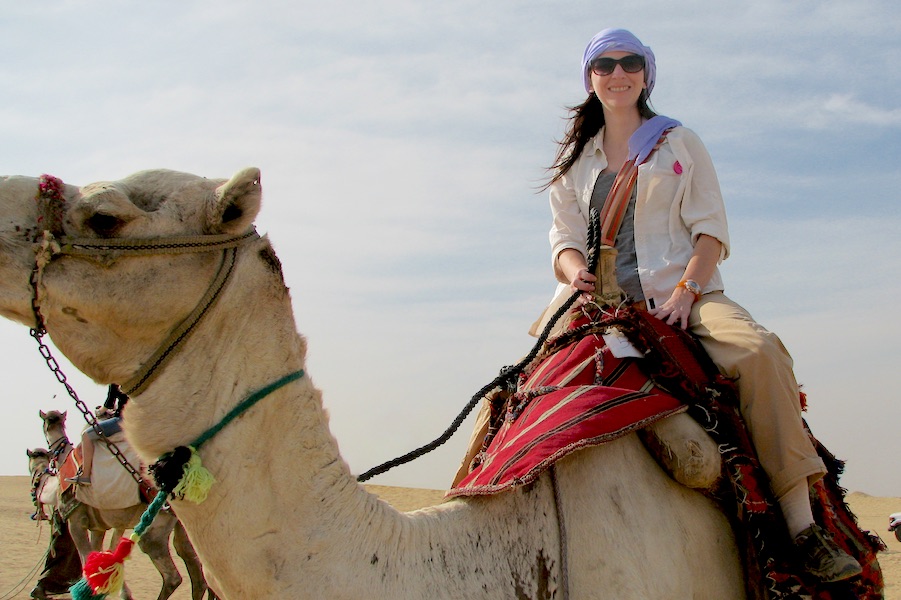When students hear Dr. Candace Livingston lecture on the art and culture of faraway places, most of what they get comes first hand from someone who’s been there.
Dr. Livingston, an art history professor in the South Carolina School of the Arts at Anderson University, has spent many of her summers as a lecturer aboard cruise ships. Her travels have taken her practically all over the world.
The COVID-19 pandemic interrupted those travels for a couple of years, but Dr. Livingston is getting ready to return to the seas this summer. From July 11-20, 2022, she’ll be guest lecturer and host on an Archaeological Institute of America Cruise of the Greek Islands aboard the three-masted sailing yacht the Sea Cloud II.
Dr. Livingston has logged thousands of miles at sea lecturing for major cruise lines. She’s also worked for Viking Cruise Lines as resident historian.
“Only Viking uses that terminology,” she said. “A lot of cruise lines have lecturers, not just on history but pretty much on anything you can imagine, especially the really large ships like Celebrity, which I’ve also done. They may have someone lecturing on history and they may have someone lecturing on how to make good travel photographs. It really runs the gamut.

Viking’s resident historians fill a different role, not only lecturing but also leading smaller discussion groups on board the ship and holding office hours in which passengers can drop by to ask questions about the history of the ports they will be visiting.”
This dream job started as a flash of inspiration when Dr. Livingston was looking through a newspaper one day.
“I was reading the New York Times. They had an advertisement for a cruise line called Voyages to Antiquity, which was a British line,” she said, noticing that they used expert lecturers on their cruise. “I had just finished my doctorate. I didn’t have a job yet and thought ‘I can do that.’”
Dr. Livingston contacted Voyages to Antiquity and during her conversation with them, she learned that one of the lecturers was Cambridge University Byzantine Scholar Dr. Robin Cormack, for whom she served as a research assistant in Los Angeles at the Getty Research Institute.
“They contacted Robin. Robin vouched for me and they took a chance,” she said. Her lectures proved popular, and she was asked back by Voyages, then later invited to speak on other lines.
Through catering primarily to retired travelers, Voyages to Antiquity cruises were sort of an archaeology boot camp for the passengers, according to Dr. Livingston.
“We’d be ported at or near an archaeological site, get off the ship, do a tour of the site, get back on the ship. If we were in the Greek islands then we would sail during lunch to get to another site, get off, go to the site, come back, have dinner, then there would be a lecture. It was almost like being in college but the whole focus was learning and visiting these sites,” she said.
Archaeology has been a keen interest for Dr. Livingston much of her life. She’s been part of excavations in Turkey and Romania and is still active in the archaeological world as part of the San Giuliano Archaeological Research Project, which has been researching Etruscan material in Italy.
“It’s a really cool project because Anderson partners with Baylor (who runs the excavation). We participate in a consortium. Sometimes I take students when I can,” said Dr. Livingston, who was recently made laboratory director for the excavation.
Cruising the seas has been a large part of Dr. Livingston’s life.

Her husband Todd, a film and TV producer and current AU adult studies student, often accompanies her on cruises (He’s pictured above with Livingston at Rhodes, Greece). Todd proposed to her on a cruise, and their wedding actually took place on the deck of the historic Cunard ocean liner the Queen Mary, anchored in Long Beach, California. Afterward, they took a cruise together—sort of a working honeymoon—with the cruise line giving them a cabin with a beautiful balcony overlooking the ocean.
Sharing her knowledge on cruises has opened up for Dr. Livingston enough interesting experiences to fill a large book. Of course, she has her favorites.
“I spent a lot of time in the Mediterranean, but actually my favorite cruise I’ve ever done as a speaker was the Black Sea—just the variety of cultures around there,” she said. “We stopped in northeastern Turkey. I lived in Turkey for a year, but had never been to the Black Sea coast; it’s almost wild in terms of nature but then there’s these little pockets of cities.”
In her travels, Dr. Livingston has hiked on Mt. Etna in Italy. She toured the home where Napoleon was exiled on the island of Elba. She’s experienced the State Russian Ballet performing “Swan Lake” in Ukraine. She’s even been to a chamber music concert on an underwater lake in Drach Cave on Mallorca with musicians playing from boats. On the other hand, she’s encountered some of the more bizarre sights, such as an upside down replica of the White House in Batumi, Georgia, formerly part of the Soviet Union.
Visiting charming seaside towns, majestic cathedrals, ancient castles and dazzling cosmopolitan cities is great, but for Dr. Livingston there’s something that outshines them all.
“I’ve seen a lot of things and I’m generally interested in all of it, but to me the experiences that really stick out from these cruises are not necessarily ‘oh, we saw this really cool thing,’ but moments when we have experiences with people,” she said.
Although Dr. Livingston has seen famous people like Pope Benedict and the King of Spain and Sovereign Prince of Monaco, her most unforgettable experiences have been with fellow travelers.
She says the smaller the cruise, the better the chance to get to know fellow travelers. Once a woman approached Dr. Livingston after a lecture—an Anderson graduate who was pleasantly surprised that the lecturer on her cruise actually came from her Alma Mater.
Another time on the African side of the Strait of Gibraltar, Dr. Livingston recalls straying off the beaten tourist path. A small restaurant caught the eye of the Livingstons and another couple they were walking with, so they stopped for a bite to eat.
“They kept bringing out more food and more food. They brought out a grill and put it by the table and grilled fish right there in front of us. It took forever, but it was the most amazing experience,” she said. “Maybe they weren’t used to serving a lot of tourists. I was thinking ‘here we are sitting with this Australian couple in Tangier with these Moroccan men fixing us lunch and it just felt like ‘I’m part of the world.’ It’s a really special feeling.”
Another particularly memorable experience took place on the beach at Normandy. Although it wasn’t connected with one of her lectures, Dr. Livingston escorted a group that included several surviving World War II veterans as they visited the Normandy American Cemetery and Omaha Beach. There she also met another passenger from their ship, the great nephew of Gen. George Patton, noted four-star general and the subject of a major motion picture.
As people start to travel again, Dr. Livingston shares tips on how to get more out of their trip. She recommends getting a travel guide (she prefers the Blue Guides for their focus on history and archeology) or researching online the places they plan to visit. She notes that traveling with a cruise line that provides cultural enrichment programs like lectures is a great way to learn while also enjoying a relaxing vacation.

“A lot of these sites, they’re so beautiful and some of them are so large; the Alhambra in Spain is absolutely overwhelming. It’s great to have an aesthetic experience like that, but when you know what to look for—maybe you heard a lecture and you know the Fountain of the Lions is really historically important. It just helps you to be more focused and engaged in what you’re seeing,” she said. “Of course you can do research on your own, but it’s great to go back on the ship and then seek out the resident historians during their office hours or find one of the lecturers and say ‘look at this thing I saw’ on your phone and talk to them about it,” she added.
Referring to other types of entertainment that are popular on many cruise ships, she noted, “I’m not saying it’s not fun to go to those shows where they do all the songs of ABBA, but I find that it’s tremendously more interesting to visit a site when you know the history.
Of course, I’m a historian, so I would say that.”

